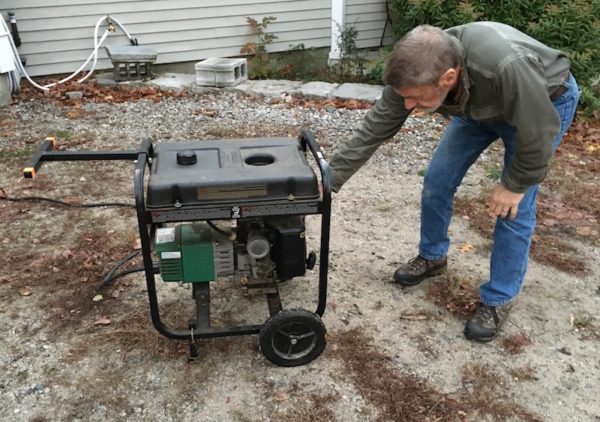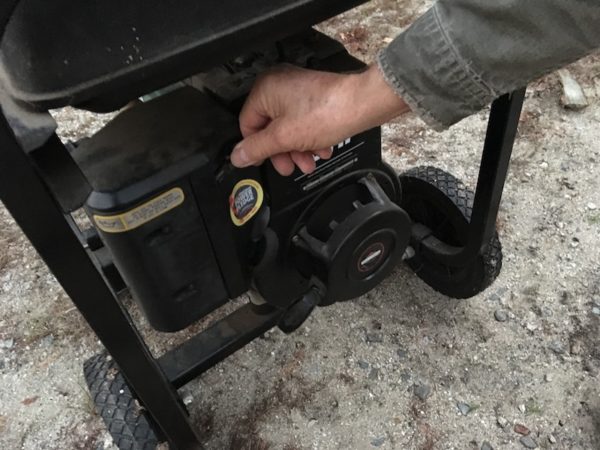
Like so many people in Maine, we don’t have any power. Fortunately, we have a generator that we’re using early in the morning and at the end of the day. It’s on right now, which is why I’m able to get online and send out this post.
Our generator is pretty small – 10 HP — but it’s still a bit intimidating. Last night and this morning my husband walked me through the important steps of turning it off (last night) and on (this morning) and how to safely fill the gas tank.
I’ve written plenty about the risk of carbon monoxide poisoning if a generator isn’t used properly, but trying to make sure I did everything right made it much more real to me. “The most important thing about a generator,” my husband reminded me, “is never ever run it inside a structure. Also, don’t leave any doors and windows open where carbon monoxide gas could get drawn into the house.”
Anything that burns fuel can be a source of carbon monoxide. The gas is produced when the fuel is not completely combusted, which can happen if an item or appliance is poorly maintained or not used or vented properly.
Since many of us don’t expect to get our power back for several days and temps are supposed to be in the 50s down to the 30s at night, some people will probably also be using things like kerosene heaters.
Here’s a list of things that could cause carbon monoxide poisoning if you’re not careful.
Carbon monoxide sources
- Generators
- Furnaces
- Wood stoves
- Kerosene heaters
- Gas-powered tools
- Gas-powered home appliances
- Gar and charcoal grills
- Cars, trucks and other vehicles

Reduce your risk of carbon monoxide poisoning
- Place generators outdoors. Never put one in an enclosed or semi-enclosed space, such as the basement, cellar bulkhead or attached garage.
- Keep the generator dry and protected from ice and snow. Dry your hands before touching a generator.
- Make sure the generator is at least 15 feet away from windows or doors into the home.
- Use kerosene heaters in a well-ventilated room, by either keeping doors to other rooms open or opening a window at least 1-inch.
- Only use K-1 grade fuel in a kerosene heater. Follow instructions for setting the wick height.
- Do not use outdoor cooking devices, such as gas or charcoal grills or gas camp stoves, indoors — not even in a fireplace.
- Do not use indoor gas cooking stoves for heat.
- Keep the chimney flue and a window open when you burn decorative gas fireplace logs for heat.
- Place a carbon monoxide detector that is battery powered or has battery back up power outside each sleeping area. Look for the UL mark with the “Single Station Carbon Monoxide Alarm” statement.
- Change the batteries in your carbon monoxide detector each time you change your clock for daylight savings time.
- NEVER ignore a carbon monoxide alarm.
- Check and clean your chimney at least once a year.
- Don’t idle the car, snowmobile or any other vehicle in a garage, even if a door to the outside is open. Fumes can
build up very quickly in the garage and living area of your home. - Do not use pressure washers, chainsaws and any other gas-powered tool inside the house, garage or an enclosed area, such as a barn or shed.
- Have fuel-burning appliances, including oil and gas furnaces, gas water heaters, gas ranges and ovens, gas dryers, gas or kerosene space heaters, fireplaces, and wood stoves, inspected by a trained professional at the beginning of every heating season.
- Make certain that flues and chimneys are connected, in good condition, and not blocked.
- Choose appliances that vent their fumes to the outside whenever possible, have them properly installed, and maintain them according to manufacturers’ instructions.
In a piece for the Bangor Daily News, reporter Jackie Farwell interviewed state toxicologist Dr. Andy Smith. He said even if you leave the doors open, it is not safe to run a generator in the garage. Dr. Smith also said not to run the generator too close to the house.
- Place generators at least 15 feet from your house. Make sure you have a long enough extension cord that’s in good condition.
- Point the exhaust away from your home and any windows, doors or vents.”
Read more: Running your generator safely? You might not know these poisoning risks
Symptoms of carbon monoxide poisoning
The problem with carbon monoxide is it’s a gas that you can’t see, smell or taste. Early symptoms of CO poisoning can feel just like the flu, only without a fever. It doesn’t take long for the situation to become serious — for someone who has been poisoned to lose consciousness and possibly die.
- Headache
- Dizziness
- Fatigue
- Shortness of breath
- Nausea
- Vomiting
- Unconsciousness
- Death
What to do if you suspect carbon monoxide poisoning
If you or someone you are caring for has any of these symptoms and you suspect CO poisoning, you should:
- Get out of the building immediately.
- Call the local fire department or 911.
- Get medical attention. Call your physician or the Northern New England Poison Center (800-222-1222).
- Do not go back into the building until you know for certain that the CO levels are safe.
Treating carbon monoxide poisoning
Treatment involves reducing carbon monoxide levels in the blood.
- Breathing pure oxygen through a mask or a ventilator if you can’t breathe on your own.
- Hyperbaric oxygen therapy may be used in severe cases or for pregnant women because unborn babies are very susceptible to the effects of carbon monoxide.
Most people who are treated right away recover within a few days. Some long-term problems can occur so be sure to watch for changes in vision, coordination or behavior.
An ounce of prevention
Of course, the best treatment is prevention, so be sure to go over the list of things you can do to reduce your risk of carbon monoxide poisoning. And don’t forget to check on family and friends (especially if they are elderly) to make sure they are ok or to see if they need any extra assistance.

Leave A Comment